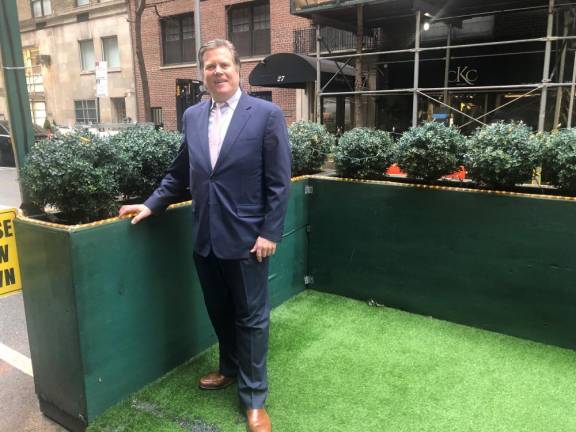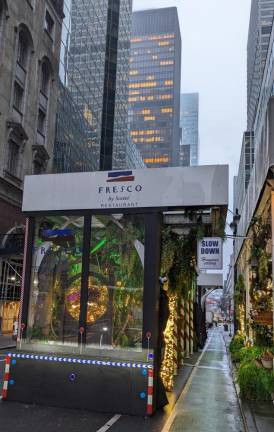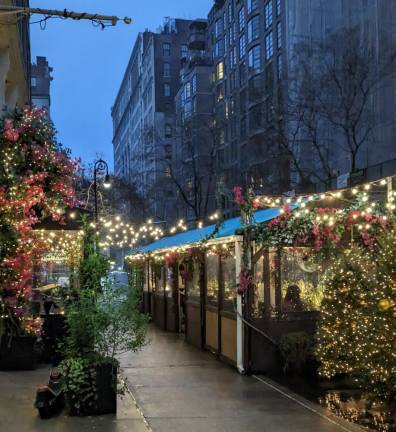Confusion Reigns as DOT Goes Slow in Enforcing Dining Shed Rules
Dining areas on sidewalks were going to be allowed to stay up year round under the new outdoor dining rules the city council passed in August. Under that rule, all the sheds in the roadways were to come down on November 29. But the Department of Transportation now says that requirement is only going to apply in 2024 after the DOT issues final rules. So it appears all sheds got an unintended one-year extension to stay up.




Outdoor dining: it’s the controversy that comes with a side of confusion so large that, even in late 2023, nobody was sure exactly what it meant, or where it’s really going in 2024.
It wasn’t supposed to be this way. But then few things in New York City are. There is a tab on the Department of Transportation, the enforcement agency, which asks: “Will there be special circumstances where a business will be allowed to operate year round in the roadway?
And the answer is unequivocal: “No. All roadway setups must be broken down by November 29 and may be reinstalled April 1 on an annual basis.”
A DOT spokes person explained, “the 11/29 date is when set-ups will need to come down once rules are in effect next year.”
Born of COVID-era safety fears, the city’s Open Restaurants program provided an economic lifeline to the restaurants, cafes and bars that were forced to close, and then afterwards limit indoor capacity. With COVID fears receding, the outdoor dining has continued with little effective regulation and even less enforcement, despite the fanfare this summer when the city council passed new laws that were supposed to govern the set ups permanently.
While the city did make some headway in removing abandoned sheds in August 2022—Mayor Adams himself took a sledgehammer to one abandoned eyesore at 5th Avenue and 32nd Street eyesore—that initiative seems to have passed, and the issue of neglected sheds of businesses that do remain open has largely been ignored.
We’ve all seen them. The slightly nicer sheds that now serve as outdoor storage units, locked, with chairs stacked inside. Others that are little more than rude, rotting wood enclosures: some empty, some filled with litter, rats, homeless people.
These structures have also, on more occasions than we’ll even know, also served as garbage dumps, toilets—even shelter from the storms of sexual passion that sometimes engulf New Yorkers.
The City Council passed Intro. 31-C, which, with much fanfare, Mayor Adams signed into law in August. Thus was born “Dining Out NYC,” touted as the “Nation’s Largest Permanent Outdoor Dining Program.”
With it came to official comments from, among others, Deputy Mayor for Operations Meera Josh; Chief Public Realm Officer Ya-Ting Liu; DOT Commissioner Ydanis Rodriguez; Department of City Planning Director Dan Garodnick; Sanitation Commissioner Jessica Tisch; Director of Small Business Services Commissioner Kevin D. Kim; and Director of Citywide Rodent Mitigation—aka “The Rat Czar”—Kathleen Corradi.
Numerous Representatives from the City Council, including the legislation’s sponsor, Council Member Marjorie Velázquez and Brooklyn Borough President Antonio Reynoso also had their say.
It seemed like a triumph of forward thinking teamwork and intelligent compromise. Moving the economy forward and providing a better quality life for all New Yorkers? Sounds like a win-win proposition anywhere. And that’s why they call us “City of Yes”!
Yet not everyone was pleased.
Said downtown Manhattan Council Member Christopher Marte, whose district encompasses one of the areas that would be most impacted by the program and outdoor dining negligence in general: “I am deeply disappointed that the recommendations from the people with most experience of living next to and on top of dining sheds were ignored. To the thousands of lower Manhattan residents that oppose this legislation, I am sorry that we have failed you.”
Recent long walks throughout Manhattan amply demonstrate Marte’s concerns. Although the New York City Hospitality Alliance, in its statement on the outdoor dining program said, “We look forward to collaborating with the Department of Transportation and stakeholders on the design guidelines and additional details to address issues that are important to restaurants and the communities they serve,” the DOT itself has announced nothing.
Further, it’s current guidance been contradictory. According to the Mayor’s office, “Restaurants actively participating in the temporary program can continue operating with existing setups through the remainder of 2023 and throughout their application process.”
But what does “actively participating” actually mean.
While we wait to find out, this reporter zig-zagged Manhattan one warm, wet afternoon and early evening in late December. The goal was find restaurants whose outdoor dining spaces are visibly active, attractive and clearly an asset to their neighborhood. Although by no means comprehensive, three establishments stood out.
At Fresco by Scotto at 34 East 52nd Street, the Italian eatery co-owned by “Good Day New York” tv co-host Rosanne Scotto and her sister Elaine Scotto, stands the veritable Taj Mahal of dining sheds. Built at a cost of around $100,000 to build.
Fresco’s General Manager, Ciprian Nourescu, a native of Romania, spoke eloquently about the value of outdoor dining. While the income generated by extra tables is certainly important, there are other benefits. Tourists especially like it, and it the extra space often allows seating customers without reservations. Though it’s been a temperate winter far, Nourescu noted he can provide heaters and even blankets to his outdoor customers as desired.
As for Fresco’s future participation in the outdoor dining program, Nourescu is awaiting the DOT guidance eagerly, albeit with some trepidation as well. Specifically, he’s concerned that very qualities have made Fresco’s shed so welcoming and robust—notably, its high quality, enclosed construction--might run afoul the DOT’s new limits.
Not too far away, Steve Millington the general manager of the media and celeb hangout Michael’s said his outdoor investment along W. 55th St. was around $20,000. Although it is adjacent to a bike path on the roadway, he says the city is allowing him to keep it up for the present because it is an open air, rather than an enclosed structure. That also means it is not being used in late fall and winter anyway, but at least he doesn’;t have to take it down and store it.
His biggest concern, he said, one speeding biker in the bike lane hit one of his customers as she was exiting the outdoor dining area--and never stopped.
The dining shed at Asuka Sushi at 300 West 23rd Street in Chelsea is more spartan and, although it has recently struck by graffiti vandals, it’s a well-maintained, and well-used, addition to this popular Japanese eatery. Manager David Gonzalez echoed the sentiments of many other restaurant professionals: outdoor dining is both popular, and its extra tables are welcome not just for financial but aesthetic reasons. Like most popular restaurants, Asuka can get quite loud when it’s crowded and, for diners who prefer a quieter ambiance, the enclosed outdoor space is a welcome option.
A similar story was heard Da Andrea, the much loved Italian eatery at 35 West 13th in the West Village, with a recently opened second location in Chelsea. While the restaurant’s exterior is festooned with lights and holiday decorations, so too is its substantial, spotless and alluring dining shed.
Da Andrea’s General Manager Sipy Thiaw, a native of Senegal, is a strong advocate of outdoor dining. While there’s certainly a financial incentive to outdoor dining, for Thiaw, the desire to serve more people, with or without reservations, is a sincere one. Whatever comes down from DOT, Da Andrea will abide and, if necessary, when the time comes, rebuild. Why? Because “people love it.”